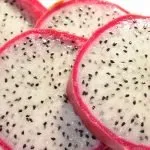While white dragon fruit (pitaya blanca) is a lot more common, the red dragon fruit (pitaya roja) is definitely worth a try. The two varieties are fundamentally different in many ways.
This overview will explain the most important differences between the two species in more detail. If you’re interested in the difference between the red and yellow varieties, check out this overview.
If you’re interested in learning more about the different varieties of this tropical fruit, also consider looking into the highly flavorful yellow dragon fruit (pitaya amarilla).
1. Red Dragon Fruit Tastes Sweeter
On average, the flavor of red dragon fruit is noticeably sweeter compared to the white variety. This is because the sugar content is higher:
Red dragon fruit has a total sugar content of 15%, compared to 10% for the white variety. This also translates into a difference in flavor: red dragon fruit tastes sweeter, with a hint of berry. Which doesn’t mean it’s unhealthy, as it already is a fruit with a comparatively low amount of sugar.
2. More Antioxidants In Red Dragon Fruit
In the health department, the red-colored exotic delicacy also comes out on top. Red dragon fruit is relatively rich in antioxidants compared to white dragon fruit. Actually, this fact is true for most red-colored fruits (as well as purple and blue ones, by the way).
We have to seek the answer in the substance that naturally causes the fruit to be red in the first place: a color pigment called Anthocyanin.
While antioxidants like Anthocyanin are often praised for their health benefits, a 2010 review by the European Food Safety Authority concluded that no evidence was found for this claim. Luckily, dragon fruit already has many health benefits which are not related to its antioxidant levels.
3. White Dragon Fruit Is Bigger
Size matters, especially when it comes to choosing the most delicious fruit. It’s often true that the more concentrated the fruit is, the more powerful the taste. This can also be said for the dragon fruit, of which the more common white variety is noticeably bigger and oval-shaped.
If you’re looking for the largest amount of flesh, choose the larger-sized white dragon fruit. If you’re looking for a more concentrated sweet flavor, go for the round-shaped red variety instead.
The exact size might differ for a whole range of reasons though. Seasonality will always play a role, but there can even be size differences in the same genus.
4. Red Dragon Fruit Costs Are Higher
The costs of dragon fruit are determined by a range of factors. One single white dragon fruit will cost $5.98 at Walmart, but that’s not the price you should expect for red dragon fruit.
Red varieties are much rarer and harder to come by, which already increases the price for a single fruit considerably. You’ll usually have to look for them in specialty fruit shops or farmer’s markets.
And like we determined earlier in this overview, the amount of fruit you get for the size is simply lower for the smaller red variety. For that, you get an arguably better-tasting fruit. So there’s definitely something you’ll be getting back for the higher cost.
5. Red Variety Is Better For Wine Making
Fruits can have interesting uses, and one of those is the production of wine. Grapes are well-known for their ability to create a wide variety, but similarly, wine can be produced from other fruits as well.
The wine-producing variety in the dragon fruit family is definitely the Selenicereus costaricensis, which is the scientific name for the red variety. The process of making the wine is not much different from how it’s done with grapes.
While ‘regular white’ dragon fruit wine exists, red dragon fruit wine is more common and overall better appreciated. This has more to do with the unique concentrated flavors than the color resemblance with red wine.
Featured image adapted from: Wikimedia Commons



